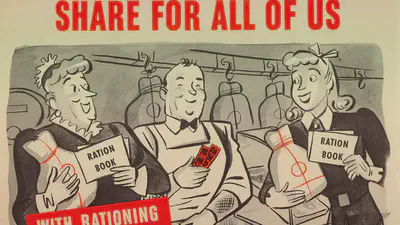1R. Perception - Weekly readings
Wansink, Brian (2002), “Lost Food Acceptance Lessons from World War II”

This article provides the background for the weekly reading.
1. Introduction
Issue: There was a shortage of traditional meat due to the war. Hence the health of the population became a matter of national security and led to the formation of Committee on Food Habits (1940-47).
Aim of the committee: To identify effective ways of adjusting food habits of the American people.
Traditional meat
The following were the themes of the six conferences held to understand about food habits:
- The problem of food acceptability
- Food preparation and serving methods
- Sampling populations for food habit studies
- Problems in the feeding of Army and civilian populations
- Regional vs. national habits and nutrition
- The relation between food consumption habits and nutritional status
The most interesting idea of all was by Kurt Lewin:
This led to change the focus on reducing the barriers which discouraged the consumption of organ meats, Lewin believed the preparation and serving habits of the gatekeeping cook could be changed.
Q. what does gatekeeping cook mean?
The person in a household who typically makes the purchasing and preparation decisions related to food.
2. Reducing Barriers to Consume
Without removing barriers to consumption, promotional incentives would be wasted. The fundamental characteristics of an accepted food from emperical studies were: Selected, Available, Familiar, Exactly as expected.
There were also other larger issues related to barriers to consumption, which stems from human behavior.
- Social norms
- Perceptions of taste
- Assimilation of variety
3. Action Plan
3.1. Reducing Barriers to Food Preparation and Acceptance
The effort to change food habits should not be broadly aimed at children or husbands.
Instead, initial efforts should be confidently aimed at the gatekeeper – the cook – who selected, purchased, prepared, and served the food.
From interviews and observations, the gatekeepers indicated the following key barriers:
- Thinking it was inappropriate to prepare food with organ meat
- Thinking it would taste bad
- Not knowing how to include the organ meat into the meals
3.2. Restructuring Social Norms
-
People’s food choices are influenced to a greater degree when eaten by people in their primary reference groups than by subordinate reference groups.
-
Foods also become more of a social norm when they were aligned with the patriotic obligation to “do one’s part for the war effort.”
3.3. Changing Perceptions of Taste
-
Familiar Preparation Influences taste
Food preparation and serving methods can influence the acceptability of unfamiliar, even unpopular, food items.
-
Observation: Longer cooking time resulted in the gradual loss of palatability and vitamins.
-
Action: A variety of organ meat recipes were designed for optimum palatability and vitamin retention. These recipes and cooking tips were commonly found where organ meats were sold.
-
Result: Recipes helped create a familiar taste that increased palatability and retained vitamins.
-
-
Familiar Appearance Influences Taste
-
Observation: Making organ meats “look” familiar (through their cuts and shapes and packaging) influenced perceptions of taste.
-
Actions: Organ meats were offered in both ground meat and sausage forms; Replacing existing meat with organ meats were accepted because they did not cause the meat to look differently than expected.
-
-
Taste Dominance within a Taste Portfolio
-
Observation: High favorability for a main dish caused less variation in the evaluation of the meal (regardless of the favorability of the side dishes).
-
Actions: Prepare highly palatable main dishes while incorporating organ meats into the side dishes until organ meats became more preferred and widely accepted.
-
3.4. Assimilating Unfamiliar Foods
Observations:
- The increased availability of organ meat stimulated perceptions of its acceptability, and increased the willingness of gatekeepers to experiment with these meats.
- It was found that high levels of variety helped increase food acceptance and adoption.
- Programs that offered variety were more successful in achieving long-term change than programs offering less variety.
Actions:
- Organ meats were then promoted by increasing the variety of options, thereby preventing monotony and a lack of food selection.
Results:
-
Gradual introduction of unfamiliar foods into one’s diet helped make the foods more acceptable
- viewed as something new and novel and not as long-term substitutes
-
A rotation of variety meats into occasional meals (instead of in every meal) was most successful because of the gradual acclamation it allowed.
Assimilation-contrast theory:
-
People refused to make dramatic changes in their dietary patterns – such as eating organ meats multiple times each week
-
They were more amenable to eating them in a less frequent manner that contrasted less with their existing eating patterns.
3.5. Increasing the Incentives to Consume
Q. how to better educate and persuade gatekeepers?
Experiment with different groups with two different education methods:
- Discussion-decision method
- Lecture method
Observation: Groups informed by the discussion-decision method were three times more likely to consider adoption.
- Government publicly reinforced organ meat consumption through rationing and advertising messages
4. Implications for Dietary Change
Potential Questions to ask:
-
How does reframing or relabeling a product (organ meats vs. variety meats, or soy vs. vegetable protein) influence perceptions of its taste?
-
What is the mechanism through which variety makes a product acceptable and is the same effect found within meals as across meals?
Implications:
-
The taste of low-fat products can be improved by making their appearance and taste match that of favored products.
-
Taste and packaging can create a sense of familiarity
5. Conclusion
These insights could still be used to incorporate new diets into general public’s diets.
Idea: Replacing animal-based meat to plant-based meat
Reference article: Plant-based meat by far the best climate investment, report finds
Impact: Significantly reduce the greenhouse gas emissions.
A. References
-
Wansink, Brian (2002), “Changing eating habits on the home front: Lost lessons from World War II research,” Journal of Public Policy & Marketing 21.1 (2002): 90-99.